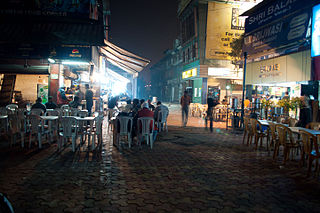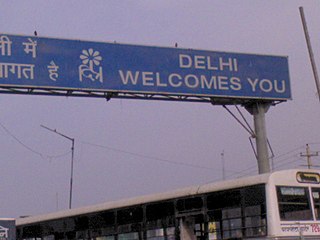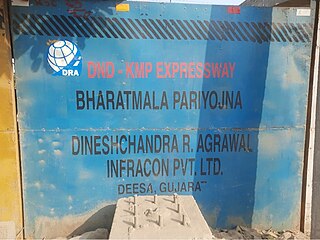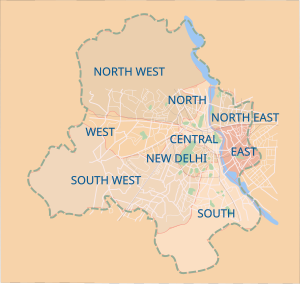
Jamia Millia Islamia is a premier central university located in New Delhi, India. Originally established at Aligarh, United Provinces during the British Empire in 1920, it moved to its current location in Okhla in 1935. It was given the deemed status by University Grants Commission in 1962. Jamia Millia Islamia became a central university in the year 1988 by an act of the Indian Parliament which was passed on December 26, 1988.

New Friends Colony is a posh residential colony of South East Delhi, India. It consists of A, B, C, D Blocks. It is situated near Uttar Pradesh border.

Okhla, short for Old Kanal Housing and Land Authority, an urban neighbourhood located near the Okhla barrage in the South East Delhi district of Delhi near the border between Delhi and Uttar Pradesh. Okhla has lent its name to the nearby planned township of New Okhla Industrial Development Authority or NOIDA. Okhla is also an assembly constituency.

Kapashera Border is one of the main Borders of Delhi. It connects Delhi to Gurugram district of Haryana state. The road connecting two said cities is referred to as Old Delhi-Gurgaon Road.
Sarita Vihar is a posh residential colony situated in South East Delhi,National Capital Territory of Delhi ,India. It is near the Kalindi Kunj- Noida Toll bridge or GD Birla Marg-Road 13A which connects the district to Noida.The area is situated close to Uttar pradesh border. It is believed that the site was primarily chosen as the construction site for the Games Village of the 1982 Asian Games, however on the insistence of the late Prime Minister Rajiv Gandhi, the plan was changed to convert it into an upscale residential housing locality. In 2013, it was awarded the "Greenest Colony in Delhi" tag by the then Chief Minister of Delhi, Ms. Sheila Dikshit, credited to the efforts of its RWA members who have aggressively worked towards improving the state of parks and green spots in the locality.

The Hauz Khas metro station is an interchange station between the Yellow Line and the Magenta Line of the Delhi Metro. It serves Hauz Khas Enclave, Sarvapriya Vihar, Vijay Mandal Enclave, RBI colony, Mayfair Gardens and the IIT Delhi. The entrance to the station is located on Outer Ring Road, to the east of Aurobindo Marg and to the west of Khelgaon Marg.
Okhla Vihar is a new settlement in Okhla, in the district of South East Delhi, India. It consists of many lanes (roads) and many sub-lanes (sub-roads). Over 80% of the area of Okhla Vihar is covered with 5-story apartments. The area consists of three mosques and a church. Amanatullah Khan is the local M.L.A from AAP.

The Okhla NSIC metro station is located on the Magenta Line of the Delhi Metro. The station was opened on 25 December 2017.

The Sukhdev Vihar metro station is newly opened located on the Magenta Line of the Delhi Metro and situated at Sukhdev Vihar

The Jamia Millia Islamia metro station is located on the Magenta Line of the Delhi Metro which was inaugurated on 25 December 2017 by Prime Minister Narendra Modi.

The Okhla Vihar metro station is located on the Magenta Line of the Delhi Metro. It is located in Abul Fazal Enclave just behind Jamia Nagar Police station. This Metro station has three gates. One named as Abul Fazal Enclave Part-I another Hari Kothi Road and the last one as Jamia Nagar Police Station.

The Jasola Vihar Shaheen Bagh metro station is located on the Magenta Line of the Delhi Metro. Jasola Vihar Shaheen Bagh is part of Phase III of Delhi Metro on the Magenta Line. The station was opened on 25 December 2017

The Citizenship Amendment Act (Bill) protests, also known as the CAA Protest, CAB Protest or CAA and NRC protests, occurred after the Citizenship Amendment Act (CAA) was enacted by the Government of India on 12 December 2019. The move sparked a widespread national and overseas ongoing protests against the act and its associated proposals of the National Register of Citizens (NRC). The protests first began in Assam and spread swiftly in other states such as Delhi, Meghalaya, Arunachal Pradesh, and Tripura on 4 December 2019. Protests broke out rapidly across the country, although the concerns of the protesters vary.

The Shaheen Bagh protest was a peaceful sit-in protest in Delhi, India, that began on 15 December 2019 and lasted until 24 March 2020. The protest was led by women who blocked a major road at Shaheen Bagh using non-violent resistance 24×7. Mainly consisting of Muslim women, the protest began in response to the passage of the Citizenship (Amendment) Act (CAA) on 11 December 2019 and the ensuing police intervention against students at Jamia Millia Islamia who were opposing the Amendment. Protesters agitated against the citizenship issues of the CAA, National Register of Citizens (NRC) and National Population Register (NPR), in addition to police brutality, unemployment, and poverty, and for women's safety. The Delhi Police barricaded major roads in and around the area, affecting more than 100,000 vehicles a day and adding hours to some journeys. Following the North East Delhi riots, police presence in the area temporarily increased with over 1000 personnel being assigned to Shaheen Bagh. After the COVID-19 outbreak in India and subsequent government-enforced restrictions the protest continued for several days in a more controlled manner. Following the complete lockdown imposed in Delhi on 23 March 2020, the remaining protesters were arrested or forcefully removed from the site by the Delhi Police.
Sharjeel Imam is an Indian student activist from Kako village of Jehanabad, Bihar. He had completed his B.Tech. and M.Tech. from IIT-Bombay and joined Jawaharlal Nehru University in 2013 for completing his master's degree in Modern History and in 2015 he started Ph.D. from the same university. He is known for his allegedly inflammatory speeches made during anti-Citizenship Amendment Act (CAA) protests which led to his arrest under sedition.

The DND–Faridabad–KMP Expressway, formally known as NH-148NA is a 59 km long, 6-lane wide access-controlled expressway in Delhi NCR, India. It connects the junction of DND Flyway and Ring Road at Maharani Bagh in Delhi with KMP Expressway at Khalilpur, Nuh district in Haryana. The NH-148NA is a spur (branch) of Delhi–Mumbai Expressway project. This expressway will have an additional 31 km long spur from Sector-65, Faridabad bypass to Jewar Airport.
Bilkis Dadi is an Indian activist who was at the forefront of protests against the Citizenship (Amendment) Act, 2019 (CAA) passed by the central Government of India. She received national and international coverage during the sit-in protest in Shaheen Bagh in Delhi. For her role in the Shaheen Bagh protest, she came to be known as one of the 'Dadis of Shaheen Bagh' and went on to be listed on the Time 100 list and BBC's 100 Women in 2020. She was named "Woman of the Year" in The World's 500 Most Influential Muslims for 2020.

Madanpur Khadar is an urban village in South East district of Delhi. It is located on Delhi-UP Border and is an 800 years old village, named after Thakur Madan Singh Chauhan. The term Khadar is attached to the village’s name because it is situated on the banks of Yamuna river. It was declared as an urban village by the administrative authorities under Delhi Metropolitan Council in 1966.

Syed Abid Husain Sr. Secondary School (SAHSSS) is a self-financed school located in Jamia Nagar, Okhla, Delhi. It falls under the jurisdiction of Jamia Millia Islamia, its parent University. When JMI shifted from Aligarh to Karol Bagh in 1925, the premises of Jamia Schools were one of the first to be built in Okhla. The school itself was founded in 1989 as a private self-financed school under Jamia Millia Islamia. Admissions are conducted on the basis of entrance examinations for classes 6th, 9th and 11th & on the basis of drawing of lots for preschool. Although the school has its own board, it follows the CBSE pattern.

Students and artists created art and graphite paintings on the walls and roads of the Jamia Millia Islamia campus in New Delhi, India, following the 2019 Jamia Millia Islamia attack by Delhi Police in December 2019. The protest art spread into the neighborhood of Shaheen Bagh and their protests, and continued to be created until January and February 2020.


















